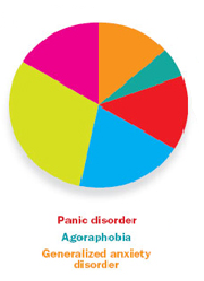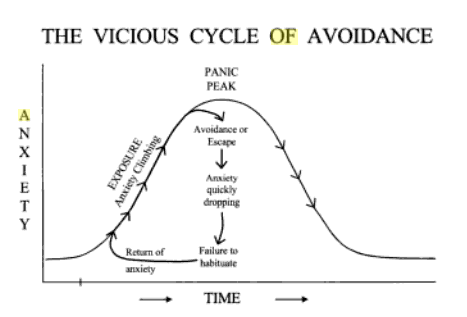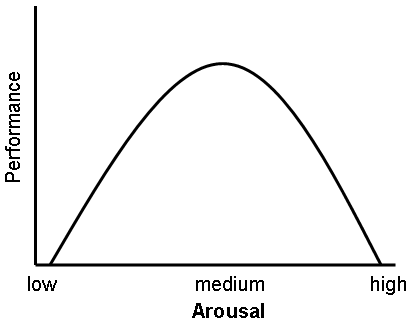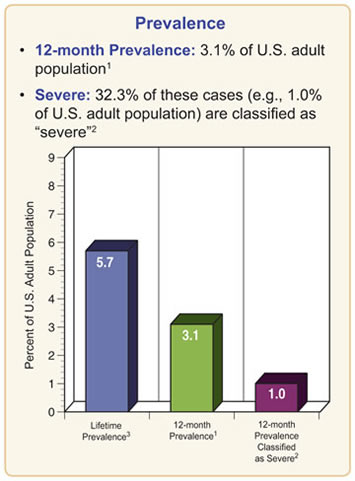Introduction
Anxiety is a common condition experienced by all human beings at some point in their lives. A person can feel anxious when he/she is faced with a stressful situation or is about to face a new and exciting condition. Mild anxiety is not only normal but it can even be useful by motivating the individual experiencing it to become more alert and focused when facing an important situation.
Blair and Yuval (2010) confirm that anxiety is a universal human emotion that helps people to be alert to potential threats and motivates them to prepare for challenges. However, anxiety can be detrimental when a person experiences extreme worry or fear. The condition where the person suffers from extreme worry or fear is referred to as anxiety disorder. Anxiety disorder is a common and costly condition in adults.
The National Institute of Mental Health (2009) reports that about 40 million adults in America (this is about 18% of the entire population) are affected by anxiety disorders. They are an important source of personal and societal cost as individuals incur significant health care costs to solve these problems.
This paper will set out to present a concise yet informative discussion on Anxiety Disorders in adults. It will begin by providing a definition of anxiety disorders and proceed to highlight the causes of these disorders, their impacts, and the treatment for the conditions.
Anxiety Disorder: A definition
Anxiety is a natural human experience that everybody has and it serves some useful roles in human life. However, an excess of this anxiety is considered abnormal and characterized as a disorder. The Diagnostic and Statistical Manual of Mental Disorders (DSM-IV) defines anxiety disorders as “a group of mental disturbances characterized by anxiety as a central or core symptom” (Gavin, 2003, p.12).
These disorders are characterized by excessive fear and worry that negatively impacts on the life of the person. Anxiety disorders transform a normal adaptive emotion into a disabling conditions affecting the ability of the individual to cope and causing significant distress. Avoidance and escape is one of the most powerful factors that perpetuate anxiety.
When faced with a threat, the anxious person is likely to escape and this fuels anxiety though negative reinforcement. Negative reinforcement occurs since the avoidance behavior leads to the avoidance of the discomfort of the anxiety, which is a desirable reward to the individual with anxiety disorder (Thomas & Michel, 2002). This promotes the avoidance behavior as a response to anxiety causing situations.
Unlike the typical anxieties that all people face, anxiety disorders are prolonged and they generally last for six months and above.
Due to their frequency of occurrence, anxiety disorders are the most common class of mental health problems for adults in the US. Some of the common features of anxiety disorders include heightened fear, physiological arousal, and expectations of imminent threats against the person (Craske, et al., 2009).
In addition to this, the person suffering from this condition exhibits avoidant behavior as he/she seeks to escape from the causes of the anxiety. The person suffering from anxiety disorders will experience excessive worry that results in the person expressing concern about the worry inducing situation.
Craske et al. (2009) illustrates that anxiety comprises of a “future-oriented mood state associated with preparation for possible, upcoming negative events” (p.1067). A person experiencing anxiety is likely to engage in behavior aimed at avoiding the anxiety-causing situation.
Examples of Anxiety Disorders
One of the more common anxiety disorders among adults is Generalized Anxiety Disorder (GAD), which affects up to 5.7% of the population. This condition has long-lasting and widespread consequences on the individual (Francis et al., 2012). With GAD, the patient demonstrates excessive worry about minor, miscellaneous, and future events that do not trouble the mentally healthy individual.
The individual suffering from this order will demonstrate intolerance to uncertainty and find ambiguous situations to be stressful leading to chronic worry (Keller, 2002). In addition to this, Francis et al. (2012) reveal that individuals with GAD are “intolerant of uncertainty and tend to overestimate the probability of occurrence for highly unlikely future events and worry about how to handle them if they happen” (p.389).
In most cases, it is hard to identify the precise cause of the feelings, which cause GAD in the person. Even so, the fears and worries that accompany GAD are real to the person suffering from this condition and they affect his/her daily activities negatively.
GAD can start during a person’s childhood and proceed over the adolescence years and into adulthood. However, the likelihood of developing GAD for the first time significantly peaks after a person reaches 30 years old.
Another anxiety disorder is panic disorder, which is characterized by sudden feelings of dread and fear. Panic attacks are accompanied by some physical symptoms that include sweatiness, a pounding heart, and dizziness. In some cases, the individual may suffer from chest pains or experience nausea as he/she is going through the attack. Panic attacks often occur without any provocation or obvious triggers.
Individuals who suffer from panic disorder live in great fear since they do not know when the next attack will happen (Yonkers, 2005). This fear is detrimental to the life of the individual since he/she might avoid engaging in certain activities for fear that he/she will have a panic attack.
Panic attacks are often followed by a fear of losing control or going crazy and the person feels detached from himself/herself (Yonkers, 2005). Panic attacks can be passed though genes meaning that a person from a family with a history of panic disorders is likely to suffer from this condition.
Social anxiety disorder is another anxiety disorder that is highly prevalent among adults. Willutzki, Teismann, and Schulte (2012) document that SAD is characterized by an exaggerated focus on what the sufferer perceives to be deficiencies in him/her.
This focus on the perceived deficient characteristics condition leads to significant social and professional impairments as the afflicted person has great fear of social or performance situations. Individuals who have SAD have unhealthy inactive lifestyles since they are not comfortable interacting with other people.
The individual makes use of evasive tactics to avoid any social performance such as public speaking or confrontations with other people.
Post Traumatic Stress Disorder (PTSD) is one of the more severe forms of anxiety disorders that might afflict adults. This form of anxiety disorder is caused by a past exposure to physically or emotionally traumatizing events such as life-threatening events, violent crimes, serious accidents, or devastating natural disasters (Stein, 2007).
Many individuals are prone to experiencing PTSD since up to half the population will encounter a traumatic event within their lifetime. PTSD can be dangerous to the adult suffering from the condition and those around him since it can lead to self-destructive thoughts and behavior. Dyer (2009) reveals that the PTSD patient is prone to instances of anger and aggression which might lead to violence.
Obsessive Compulsive Disorder (OCD) is an anxiety disorder that is characterized by persistent thoughts that might be of an upsetting nature. These persistent thoughts are on fundamental life themes such as aggression, sex, religion, and health (Tortora & Zohar, 2008). The obsessions might be of an aggressive nature such as killing somebody or robbing a bank.
Patients suffering from OCD fear that they might act on their obsession leading to some terrible outcome. These concerns might lead to extreme behavior to avoid acting on the impulse that the person has. Most patients feel the need to engage in routines that are meant to control the anxieties produced by the obsessive thoughts.
The routines developed to deal with the anxieties are called rituals and in many cases, they help to control the anxieties that the individual feels. However, the relief produced by these rituals is only temporary and the person will have to engage in the rituals many times
Causes of Anxiety Disorder
Anxiety has no known cause but there are a number of risk factors for the disorder have been identified. One risk factor is the genetic makeup of a person. The biology of a person plays a part in causing anxiety disorders since some people have a genetic predisposition to developing this disorder. If there is a history of anxiety disorders in the family, a person has a great susceptibility towards anxiety.
Nutt and Ballenger (2008) states that while the mechanism for inheritance of anxiety disorders is not fully understood, there is a general tendency to inherit traits such as sensitivity, fearfulness, and high reactivity. These traits are associated with higher probability of having anxiety disorders.
Anxiety disorder in adults can be caused by emotional or physical abuses experienced during childhood. Research indicates that anxiety disorders such as Social Anxiety Disorder (SAD) and Panic Disorder (PD) in adults may be caused by certain forms of childhood abuse suffered by the individual (Lochner, et al., 2010).
Individuals who have had traumatic childhood experiences such as familial violence, parents’ marital problems, parents’ separation or divorce, and sexual abuse in the family are more likely to develop these disorders. While both physical abuse and emotional abuse are predictive to the development of anxiety disorder, emotional abuses are more damaging.
Childhood emotional abuse such as excessive bullying, teasing, and ridicule is more associated with anxiety disorders than physical or sexual abuse. Lochner et al. (2010) state that emotional abuse is more predictive of anxiety disorders such as SAD and PD than physical abuse. Neglect in childhood also contributes to the development of anxiety disorders in adults.
Stressful life events can also lead to the development of anxiety disorders. These events are diverse in nature and they may include death of a family member or a loved one, poor health conditions, accidents, or interpersonal and family issues. The events lead to the development of anxiety disorder when the individual adopts poor coping mechanisms to the events.
A study on GAD prevalence among university students showed that individuals with stressful life events were more likely to report GAD compared to those without the stressful events (Francis et al., 2012). The relationship between stressful life events and anxiety disorders is that these events create new worry leading to the implementation of poor coping strategies that result in excessive anxiety.
Use of drugs and substances abuse can results in the development of anxiety disorders. Nutt and Ballenger (2008) document that excessive caffeine use or withdrawal might lead to the development of significant anxiety symptoms. In addition to this, some commonly prescribed medications have anxiety as a side effect. Using these drugs for a prolonged period of time might result in the anxiety progressing to an anxiety disorder.
Impacts of Anxiety Disorder
Anxiety disorders have a number of significant negative effects on the individual and the society as a whole. These disorders lead to a reduction in the quality of life for the individual. Anxiety disorders can be disruptive to the person’s life by making him unable to engage in normal activities.
For example, disorders such as panic attacks can be disabling since the person might avoid normal activities such as driving or going to for shopping due to fear of the next attack.
The National Institute of Mental Health (2009) notes that up to 33% of individuals with panic attacks disorder are housebound or are unable to venture outside without the accompaniment of a trusted person. In the case of OCD, the individual suffering from this disorder may avoid situations that trigger the obsessions. This might prevent the person from carrying out their responsibilities at home.
The coping mechanism employed by the adult who suffers from anxiety disorder might lead to additional symptoms. There is an association between anxiety disorders and chemical dependency in adults. Patients suffering from anxiety disorder are likely to seek escape from their condition through drugs and alcohol.
The National Institute of Mental Health (2009) elaborates that many people use alcohol and other chemical substances to mask anxiety symptoms and enable them to experience reduced anxiety. Gavin (2003), who reveals that substance abuse incidents are reported to be more frequent than expected in patients with anxiety disorders, corroborates this observation.
Anxiety disorders cause strain in the personal and professional relationships of the personal suffering from the conditions. A person with anxiety disorders is unable to maintain normal relationships due to the intense fear and worry that the person has. Nutt and Ballenger (2008) reveal that the patient has trust issues and finds it hard to cooperate with other people.
In the work setting, this lack of trust and cooperativeness will have adverse impacts especially when the person is expected to work in collaboration with other people. Anxiety disorders can lead to alienation and difficulty in maintaining personal relationships. For example, PTSD might lead to emotional numbness making it hard for the person suffering from the disorder to form close relationships with friends, family, or new relations.
There are significant financial burdens imposed on the person because of anxiety disorders. This disease leads to increased health care expenditure for the person. Since anxiety disorders can be managed through treatment, the person suffering from the disorders will visit health care professionals for medication. The person suffers from anxiety disorders, he/she will therefore have an increased use of health-related services.
The financial impact of anxiety disorders is made worse by the reduced productivity exhibited by the individual due to this condition. As such, the person suffers from additional expenses incurred through access to health care facilities while his/her earning opportunities are reduced.
Treatments for Anxiety Disorders
Many people underestimate the seriousness of anxiety disorders since anxiety is deemed a normal condition. However, anxiety disorders can lead to many adverse effects on the person suffering from the condition and the society (Gavin, 2003). It is therefore crucial to look for ways to treat these disorders and mitigate the severe consequences associated with them.
Anxiety disorders can be treated by use of medication prescribed by a physician. Appropriate detection of anxiety disorders is necessary if the individual is to be given the appropriate treatments. The type of anxiety disorder afflicting an individual will influence the choice of treatment used by the doctor.
Most physicians make use of medication to reduce symptoms and mitigate the major adverse effects of anxiety disorders. The anti-anxiety medication offered helps by reducing the anxiety or dealing with the physical symptoms that bring about anxiety (Bandelow, et al., 2012). Antidepressants are also used since there is a strong correlation between depression and anxiety disorders.
Proper medication enables the person to lead a normal life and avoid the disabling impacts of the disorders. Most of the medications prescribed are aimed at reducing the emotional sensitivity to stress and the avoidance behaviors related to specific situations.
Another form of treatment is psychotherapy and it is offered by psychiatrists. Through this treatment, the patient talks with the mental health professional and is helped to discover what exacerbates the disorder (National Institute of Mental Health, 2009). The harmful coping methods used by the patient are also identified during these sessions.
With this information, the trained mental health professional is able to assist the patient to come up with ways to deal with the condition. Unlike medications, which do not cure the disorders, effective psychotherapy will lead to complete curing.
In addition to medication and psychotherapy, proper dieting and exercising can be used to offset some anxiety disorders. For example, SAD, which is characterized by low social confidence, can be decreased by high-intensity aerobic exercise, which lowers anxiety sensitivity (Jazaieri, 2012).
Exercising assists by increasing personal confidence in an individual. Exercising also leads to a sense of wellbeing which reduces depression and leads to less anxiety.
Over the past decade, there has been increased awareness about anxiety disorder by health care professionals (Bandelow, et al., 2012). This awareness has led to a desire to improve the quality of life for the patients through medical intervention. More treatments for anxiety disorders are being discovered as greater research is done on the topic.
Utilizing these interventions will ensure that a person suffering from these conditions can be cured or have his symptoms mitigated. Willutzki et al., (2012) warns that if anxiety disorders are left untreated, they might lead to the development of other mental disorders such as depression in the patient therefore further decreasing his/her quality of life.
Conclusion
This paper set out to provide an informative discussion on anxiety disorders, their causes and treatments. The paper began by highlighting that a large proportion of the population experiences an excess of anxiety that is counterproductive or even disabling.
This paper has shown that individuals with anxiety disorders suffer from the adverse effects of their excessive anxiety since it impairs their work and personal relationships, and limits their activities and opportunities. The paper has shown that anxiety disorders should be treated to mitigate or completely eliminate the negative consequences associated with them.
List of Figures

Fig 1. Chart of Anxiety disorders

Fig 2. The vicious Cycle of Avoidance

Fig 3. Graph of performance Against Anxiety levels

Fig 4. Generalized Anxiety Disorder in the US
References
Bandelow, B., Sher, L., Bunevicius, R., Hollander, E., Kasper, S., & Zohar, J. (2012). Guidelines for the pharmacological treatment of anxiety disorders, obsessive – compulsive disorder and posttraumatic stress disorder in primary care. International Journal of Psychiatry in Clinical Practice, 16 (2), 77–84.
Blair, S.H. & Yuval, N. (2010). Anxiety Disorders: Theory, Research and Clinical Perspectives. Cambridge: Cambridge University Press.
Craske, M., Rauch, S., Ursano, R., Prenoveau, J., Pine, D.S. (2009). What Is an Anxiety Disorder. Depression and Anxiety, 26(2), 1066-1085.
Dyer, K. (2009). Anger, aggression, and self-harm in PTSD and complex PTSD. Journal of Clinical Psychology, 65(10), 1099-1114.
Francis, J., Moitra, E., Dyck, I., & Keller, M. (2012). The Impact of Stressful Life Events on Relapse of Generalized Anxiety Disorder. Depression and Anxiety, 29(1), 386–391.
Gavin, A. (2003). The Treatment of Anxiety Disorders: Clinician Guides and Patient Manuals. Cambridge: Cambridge University Press.
Jazaieri, H. (2012). A Randomized Trial of MBSR Versus Aerobic Exercise for Social Anxiety Disorder. Journal of Clinical Psychology, 68(7), 715-731.
Keller, M.B. (2002). The Long-term Clinical Course of Generalized Anxiety Disorder. J Clin Psychiat 63(8), 11-16.
Lochner, C., Seedat, S., Allgulander, C., Kidd, M., Stein, D., & Gerdner, A. (2010). Childhood trauma in adults with social anxiety disorder and panic disorder: a cross-national study. Afr J Psychiatry, 13(1), 376-381.
National Institute of Mental Health (2009). Anxiety Disorders. Washington, DC: NIH Publications.
Nutt, D.J., & Ballenger, J.C. (2008). Anxiety Disorders. Boston: John Wiley & Sons.
Stein, J.D. (2007). Clinical Manual of Anxiety Disorders. NY: American Psychiatric Pub.
Thomas, J., & Michel, H. (2002). Handbook of Mental Health in the Workplace. NY: Sage.
Tortora, M., & Zohar, J. (2008). Current Treatments of Obsessive-Compulsive Disorder. NY: American Psychiatric Pub.
Willutzki, U., Teismann, T. & Schulte, D. (2012). Psychotherapy for Social Anxiety Disorder: Long-Term Effectiveness of Resource-Oriented Cognitive-Behavioral Therapy and Cognitive Therapy in Social Anxiety Disorder. Journal of Clinical Psychology, 68(6), 581-591.
Yonkers, K.A. (2005). Influence of Psychiatric Comorbidity on Recovery and Recurrence in Generalized Anxiety Disorder, Social Phobia, and Panic Disorder: a 12-year Prospective Study. Am J Psychiatry, 162(6), 1179–1187.